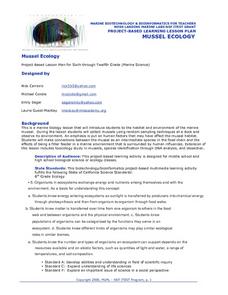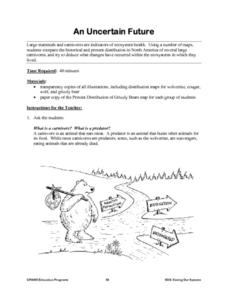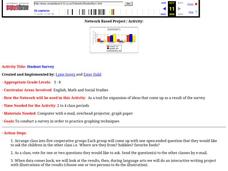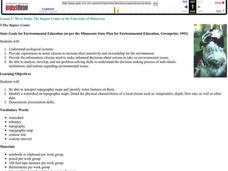Curated OER
Name that plant!
What is a dichotomous key? When your kids ask, hand them a learning exercise like this one, to explain it. They use the key to identify four different trees, based on the budding twigs they've produced. Tip: Have learners extend this...
Curated OER
Empty Oceans
In groups of four, pupils brainstorm about seafood. They view the Monterey Bay Aquarium Seafood Watch website to examine the problems caused by the seafood industry. Learners are then brought back together to discuss what they...
Curated OER
Whales
First graders investigate two different types of whales; toothed and baleen. They describe what the different types of whale eat. They listen to a cassette of Dyan Sheldon's, The Whale Song before making stick puppets to dramatize the...
Curated OER
Mussel Ecology
Students are introduced to the marine environment of the mussel. The emphasis of the lesson is upon what human factors are present to influence the environment in positive and negative ways. They brainstorm in groups in order to conduct...
Curated OER
What Should I Know about Biosphere?
If your class is learning about the biosphere, you may find a study guide or reading guide helpful. Focusing on vocabulary, processes, and interactions, the Word document is easy to edit as needed to fit your needs. Another great...
Curated OER
Wildlife
The centerpiece of this lesson plan is a predator-prey simulation in which colored paperclips represent different species of animals camouflaged against a colored background. Relevant follow-up questions are provided. The activity is...
Curated OER
Illinois Biodiversity
Students examine the amount of biodiversity in the state of Illinois. They practice using new vocabulary and listening to stories about animals. After given time to reflect, they write their own haiku. They work together to create a...
Curated OER
Seed Dispersal
Pupils explore seed dispersal by designing their own wind dispersed seed structure. Using one piece of paper and a box fan, they construct a seed dispersal structure, record the distance their seed travels, and answer discussion questions.
Science Matters
Island Fox Outreach
Off the coast of California lives a wild animal called the Island Fox. Experts discuss the importance of the Island Fox to the Channel Islands and the balance the fox creates within its ecosystem. The lesson plan concludes with a reading...
Curated OER
An Uncertain Future
Young scholars study the distribution of large mammals and carnivores in an ecosystem. Using maps and historical data, they examine areas for these animals such as refuges, untouched forests, prairies and grasslands. Students determine...
Curated OER
Mountain Lions in Arizona Overview
Here is an overview to a unit on the mountain lions of Arizona. Six different lessons take youngsters on a complete investigation of the adaptations, diet, population density, and management of these beautiful wild cats. Each of the...
Curated OER
Tracking Ocean Ecology
Students look at the data maps given to them about how chlorophyll affects the algae blooms and make predictions about the harm they will cause. In this data maps lesson plan, students manipulate data sets from the website.
NorthEast Ohio Geoscience Education Outreach
Ecosystems and Change
Pairs of ecologists select an animal and investigate an ecosystem from its point of view. This simple lesson involves Internet research and putting together a presentation of collected information.
Curated OER
Down in the Dumps
After an introduction to municipal sludge, middle school ecologists consider the pros and cons of dumping in the Hudson River Canyon. The class is split into two groups: one to debate in favor or dumping and one to debate against the...
Curated OER
Birds Learning Cycle Lesson Plan
Ninth graders explore the various adaptations of birds and compare differences and similarities of different birds.
Curated OER
Predator-Prey Relationships
Students understand ecological systems. They provide experiences to assist citizens to increase their sensitivity and stewardship for the environment.
Curated OER
The Alphabet of Culture
Students research a global culture following teacher-created guidelines and break the culture into small sections. They link the sections and find the influences that each component of culture has on another component.
Curated OER
Determining The pH Of Common Substances
Students use a pH indicator to measure the pH of some fruits, common beverages, and borax. Students discover how to differentiate between an object that is an acid or a base.
Curated OER
Radical Raptors
Learners study the lifestyles and habitats of raptors that live in Minnesota. They play games associated with their study.
Curated OER
Wetland Wonders
Students study the characteristics of wetlands, and their importance to humans and wildlife.
Curated OER
Macroinvertebrate Sampling
Students identify macroinvertebrate species to investigate ecological systems and the relationship between humans and the environment.
Curated OER
Student Survey
Students create questions they would like to ask another class of Students, send the questions by email, examine results, and create slideshow illustrating results.
Curated OER
Creation Mythology
Students construct a map from geographic data and explain relationships found in the information. Students identify ancient beliefs and customs through Hawaiian creation myths while comparing similarities and differences and appreciating...
Curated OER
River Study
Pupils explore a stream in their area and show the class the topographic map of the stream. They locate the topographic map and name the streams, lakes and ponds in their watershed. They write a paragraph about their stream and complete...

























